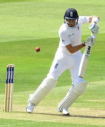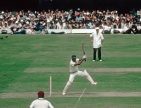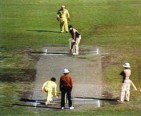Garth Le Roux: Rolling Thunder
Gareth Bland |
My first view of the cricketing Hercules that was Garth Le Roux came on a balmy Sunday evening in 1982. Back then, in the blessed terrestrial only days, the John Player League played a central part in the BBC’s afternoon-long Grandstand coverage. Flitting back and forth from athletics, Formula One Grand Prix racing, assorted equestrian activities and the cricket, Auntie’s summer schedule attempted, and most often succeeded, in pleasing everyone. At some point in the late afternoon as the cameras beamed back to The County Ground in Northampton and the relaxed tones of commentator Peter Walker, I became transfixed by the thunderous hitting from the Sussex number five. Requiring 214 for victory following Northamptonshire’s earlier top order consistency in the first knock, the visitors were in some disarray when Garth Le Roux appeared with the score at 29-3.
What followed was an exhibition of clean Bothamesque hitting by Le Roux to hand Sussex victory by 4 wickets with an over to spare. He clearly exuded genuine quality and had a touch of the star about him, too. Wearing the iconic Stuart Surridge mitten gloves which were wrapped around the handle of a Jumbo bat that could easily have doubled as a barn door, the huge frame heaved blow after blow into the stands. Sandy haired and moustachioed, his was a distinctive appearance. If the international cricketing community had initiated its own Village People tribute band, then our man would have a been a shoe-in as the construction worker. Why, then, was this match winner not better known to me? How could someone this good not be playing Test cricket? As the game neared its conclusion, one of the commentators uttered the phrase which explained everything. Referring to Le Roux in passing, it was exclaimed that “the South African” was enjoying another excellent season. Ah, that explained it then: South Africa.
Garth Sterling Le Roux had come to the attention of the cricketing world way before my immersion in it, of course. Born in 1955 and debuting for Western Province in 1975, his form with the ball in the 1977/78 Currie Cup in South Africa had alerted Tony Greig of his potential as the nascent World Series Cricket project was due to take off Down Under. As the second season of Packer’s enterprise was about to get under way it seemed inevitable that Le Roux would play. Back then, however, it was considered politically insensitive for South Africans to compete against West Indians without them having played county cricket first. With this in mind, Eddie Barlow arranged for Le Roux to spend the preceding half season with Sussex seconds in an effort to legitimise the Western Province quick bowler and to initiate him into the Packer environment.
Despite his name not being as familiar as his exalted colleagues in the Rest of The World team, it soon became obvious just what all the fuss was about. All of a sudden the Australian alternative season of WSC was buzzing with talk of the man who had snared 53 wickets for Western Province the previous winter. For one thing, he was not just fast, he was very fast. In his lone season with World Series Cricket he was made Man of The Series for his 17 wickets at 15.88 in the Supertests. Incredibly, his strike rate was such that he claimed a wicket every 38.1 balls. His scalps were not exactly bunnies either, for Le Roux had the capacity to put the wind up the greatest of batsmen.
In a limited overs contest in Sydney in December 1978 the Australians were bundled out for 100 as they chased a paltry 163. Le Roux dismissed the Chappell brothers and Bruce Laird in his opening spell before taking his sweater with figures of 3-6 off 5 overs. He was clearly not afraid to mix it with the best and did not seem overawed in the least. Developing a personal rivalry with Lillee, his aggression and approach to the crease marked him out as one of WSC’s stars; no mean feat given the stellar talent on show. Of his run in, Alan Lee observed in “A Pitch in Both Camps”, his account of the official Ashes tour and the parallel WSC series:
“Thundering in with the physique of an all-in wrestler and the gait of a stampeding bear, the South African was a fearsome proposition”
Indeed, if Michael Holding was Whispering Death then Le Roux was Rolling Thunder. A polar opposite to the languid Jamaican, nobody present could have been in the slightest doubt that Le Roux was on his way in to the delivery stride.
Le Roux enjoyed a fine career with Sussex, whom he represented until 1987. At one time forming a formidable county new ball pairing with Imran Khan, they were just about the cream of the circuit. In all he claimed 393 scalps for the south coast county at an average of 23.16, while his domestic return in South Africa for Western Province, whom he represented until 1989, was even more impressive. A total of 379 wickets came at a cost of 19.22.
In the absence of Test match cricket, Le Roux’s 59 wickets in unofficial “Tests” for South Africa between 1981/2 and 1986/87 were bagged at a rate of 23.06. Here again, exalted opposition brought out his tigerish qualities as he claimed a “Test” hat-trick against the 1986/87 Australians, while he had also roughed up the touring West Indians in successive seasons, too. This, along with his splendid WSC year of 1978/79, is the lasting testimony to his quality at the elite level.
Invariably batting in the lower middle order, he never made a first -class century, although he did finish his career with a very respectable average of 25.72 and a personal best of 86 made for Western Province. He compiled a further 25 half-centuries throughout his first-class career, his batting notable for its quickness of eye, sheer strength and clean striking.
South Africa’s forgotten men of the isolation years numbered more than Barry Richards and the Pollock brothers. Along with Mike Procter, aficionados of the game around the cricket playing world missed out on Clive Rice, Peter Kirsten, Vincent van der Bijl, Steve Jefferies, Jimmy Cook, Ken McEwan, Rupert Hanley and, of course, Garth Le Roux among many. Rarely glimpsed outside of their homeland, how lucky we were to have witnessed the contribution of so many of them to the English domestic game.
Garth Le Roux’s life beyond the cricket field has not always been easy. In 2010 The Cape High Court overturned a conviction for tax fraud and cleared the former fast bowler of charges which had landed him with a four year prison sentence in 2008. Back enjoying his life after a traumatic few years, Le Roux remarked: “finally there’s an end to the torture that felt as if it would never end”.
What of Le Roux the fast bowler, though? How good might he have been had he not had to endure his whole career in international isolation? For a considered view, it might be worth bearing in mind the words of one of Garth Le Roux’s greatest cricketing compatriots, a man who enjoyed a truncated Test career of just seven Tests before the darkness of isolation set in. The great Mike Procter, himself a whirling, swirling fast bowler and spectacular striker of the ball, said:
“Having played with Peter Pollock in Test cricket, I am certain Garth Le Roux would have been a worthy successor in the business of unsettling batsmen with pace, hostility and aggressive personality”





Top article mr bland,happy b/day for today.
Comment by Roy gibbs | 12:00am GMT 13 November 2013